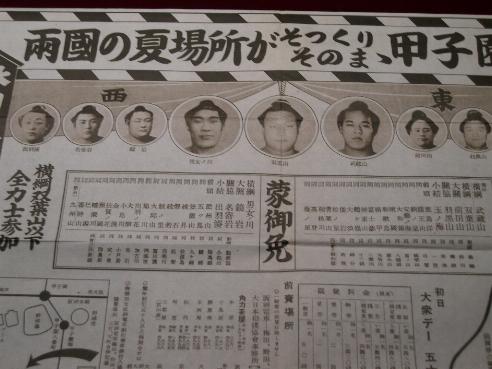|
SOS - Shinjinrui on Sumo |

|
Chris Gould
Chris sinks his teeth into how sumo can go about pulling in the younger
fans - currently so noticeable by their absence. The first of a
three-part series.
|
|
|
Sumo World Championships |

|
Mark Buckton
Mark Buckton reports from Sakai near Osaka, site of the latest Sumo World Championships.
|
|
|
Rikishi of Old |


|
Joe Kuroda
Joe Kuroda finishes off his look at former yokozuna Minanogawa.
|
|
|
Sumo 101 / Eric Evaluates |

|
Eric Blair
Eric expains sumo fan terminology - with the inevitable twist - for
those just getting into the sport and still subject to the know it alls.
|
|
|
Age stands still for no man |

|
Joe Kuroda
Former ozeki Kiyokuni will retire in November under the compulsory '65
and you are out' rule. JK takes a look at this quiet earth mover.
|
|
|
Feel the Sumo |



|
Eduardo de Paz
Read and feel the renowned Leonishiki's passion for all things sumo at his first live event.
|
|
|
SFM Interview |

|
Mark Buckton
Mark interviews Colin Carroll - again - Irish star of Sakai.
|
|
|
Photo Bonanza |

|
See the Aki Basho bonanza as well as the largest collection of pics you
are likely to see on the Sumo World Championships earlier in October.
|
|
|
Aki Basho Summary |


|
Lon Howard
Lon wraps the September Aki Basho and throws in some henka sighting results for good measure.
|
|
|
Lower Division Rikishi |


|
Mikko Mattila
The lower divisions, their members and results get the once over thanks to Mikko's eye of things 'beneath the curtain'.
|
|
|
|
|
Kimarite Focus |



|
Mikko Mattila
Mikko's latest clarification of several of the sport's plethora of kimarite.
|
|
|
Amateur Angles |


|
Howard Gilbert
Howard Gilbert - manager of New Zealand's amateur sumo team takes a look at the approaching Russians.
|
|
|
Kokugi Konnections |


|
Todd Lambert
Click on Todd's bimonthly focus on three of the best sumo sites online.
|
|
|
Fan Debate |

|
Facilitator - Lon Howard
Jesse Lake and Rich Pardoe hammer out their differences on a current furor - promotion criteria.
|
|
|
SFM Cartoons |
|
Benny Loh & Stephen Thompson
In this issue's cartoon bonanza, sit back and enjoy Benny Loh's
offerings and put a caption to Stephen Thompson's picture to win
yourselves a banzuke.
|
|
|
Sumo Odds ’n’ Ends |
|
SFM's interactive elements including Henka Sightings, Elevator Rikishi and Eternal Banzuke!
|
|
|
|
|
Readers' Letters |

|
See what our readers had to say since we last hit your screens.
|
|
|
Sumo Quiz |
|
The Quizmaster
Answer the Qs and win yourself next basho’s banzuke.
|
|








